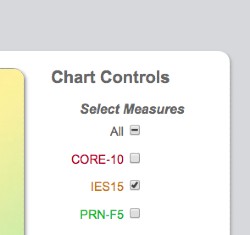Scatter Chart overview
The scatter chart provides an overview of how all clients are doing on 1 screen. Each dot represents a client and a representation of 1st and last available score for a particular measure. The 'X' axis is the 1st score and the 'Y' axis is the most recent score available (often the final score).
Which side of the track should I look?
The diagonal dotted line running from bottom left to top right is the 'no change' line. Any dot on this line or to the left of it indicates cases not changing positively according to the measure in question.
To zoom in on any particular case just hover on it to see the score and click on it to jump to the client chart.
 .
. 
My caseload on the scatter chart (5 mins 30 secs)
Aggregated data on the scatter chart (2 mins 40 secs)
Scatter Chart controls
To the right of the scatter chart are the chart controls. This determines what's displayed on the chart.
One can choose to view all measures or any combination of measures. However, making sense of the scatter chart is easier when just 1 particular measure is chosen. This may, for example, be the measure your organisation has chosen to use as its routine benchmark measure.

Individual practitioner result
Regardless of client list size the scatter chart provides a quick overview of client progress on any measure.

Scatter Chart Results
Summary Data
The results displayed on the summary data depend on which measure (or combination of measures) has been chosen on scatter chart controls and which client group were filtered on the client list page. The screenshot below shows that for 862 clients who were measured using the Impact of Events scale (15 items) and who had at least 2 measurement points (typically measured at start and end of treatment) the average score at 1st measurement point was 51 and the average at 2nd measurement point was 25.8. The effect size was calculated using a standard effect size calculation and the result was an effect size of 1.77.
Effect size
For an explanation about effect size and how it's calculated please click here.




